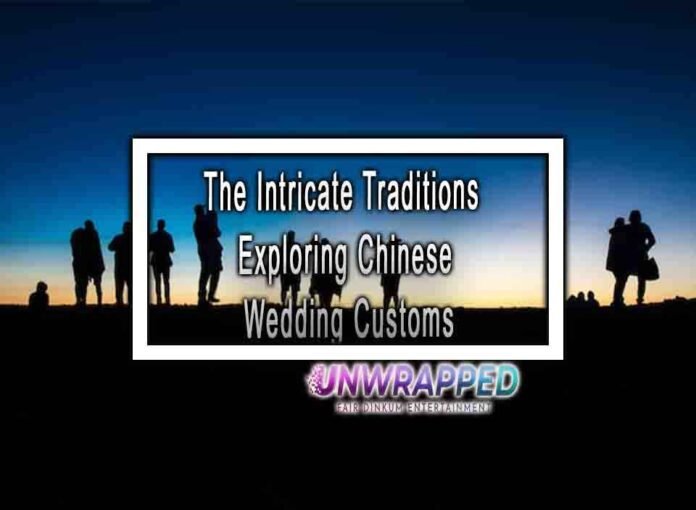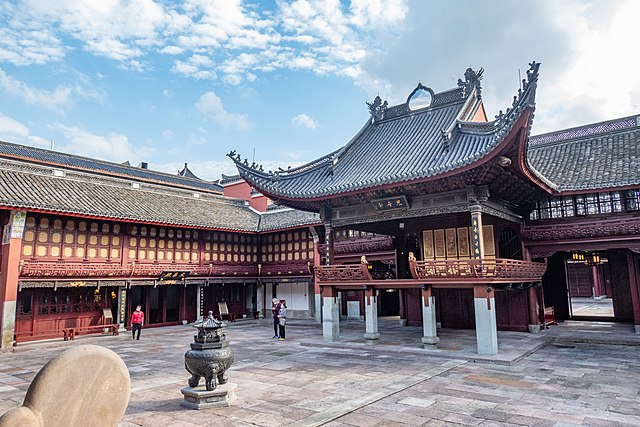Chinese wedding customs are rich in tradition and have been passed down through generations, reflecting the country’s deep cultural heritage. These customs are symbolic and carry profound meaning in Chinese society. Here’s an exploration of some intricate Chinese wedding traditions:
1. Red as the Auspicious Color:
- Red is considered the most auspicious color in Chinese culture. It symbolizes happiness, good fortune, and prosperity. Consequently, red is prominently featured in Chinese weddings, from the bride’s attire to decorations.

2. Wedding Date Selection:
- The selection of the wedding date is a crucial step in Chinese wedding customs. Couples often consult a Chinese calendar or a fortune-teller to choose an auspicious date and time for the ceremony, as it is believed to influence the couple’s future.
3. Tea Ceremony:
- The tea ceremony is a significant ritual in Chinese weddings. The bride and groom serve tea to their parents and other family members as a sign of respect and gratitude. In return, they receive blessings and gifts.
4. Bridal Attire:
- The bride typically wears a red qipao or a traditional bridal gown called a “cheongsam.” In some regions, the bride may have multiple gown changes, including a Western-style white wedding dress.
5. Dragon and Phoenix:
- Symbolism is prevalent in Chinese weddings, and the dragon and phoenix represent the groom and bride, respectively. The dragon symbolizes strength and the phoenix represents beauty and grace.
6. Red Envelopes (Hongbao):
- Red envelopes, known as “hongbao,” are given by guests to the newlyweds as gifts. These envelopes typically contain money and are considered tokens of good luck and prosperity.
7. Double Happiness (Shuangxi):
- The “double happiness” character (囍) is a common symbol used in Chinese weddings. It is often seen on banners, invitations, and decorations, representing the joy of the occasion.
8. The Veil of Crying Goodbye:
- Before the ceremony, the bride wears a red veil that she only removes after being escorted to the groom’s house. The act of crying symbolizes her sorrow at leaving her family but is also an expression of gratitude.
9. The Wedding Procession:
- In traditional Chinese weddings, there is a procession from the bride’s home to the groom’s house, often accompanied by a lively parade and music. The bride is carried in a sedan chair, and the groom rides a horse.
10. Firecrackers and Loud Celebrations:
- Firecrackers are set off to scare away evil spirits during the wedding celebrations. The festivities are typically loud, lively, and filled with laughter and music.
11. Matchmaker’s Role:
- In the past, the matchmaker played a significant role in arranging marriages. Although this role has diminished in modern times, matchmakers still have a symbolic presence in some ceremonies.
12. Unity Candle:
- In some Chinese wedding ceremonies, a unity candle may be lit together by the couple to symbolize their union and the joining of their families.
13. Wedding Banquet:
- The wedding banquet is a central part of Chinese wedding customs. It is an elaborate and festive affair, with multiple courses of delicious food and toasts to celebrate the couple’s union.
Chinese wedding customs are a beautiful blend of tradition and symbolism. While modern Chinese weddings may incorporate Western elements, these age-old customs continue to play a central role, connecting the couple to their cultural heritage and uniting families in celebration.











